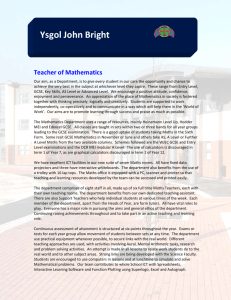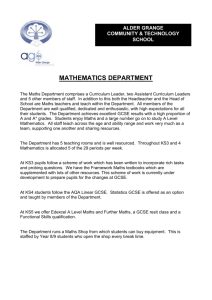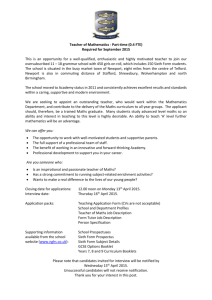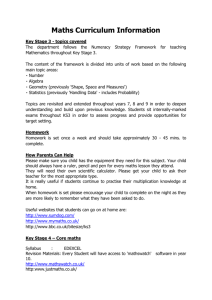Focus of the Month May 2016 Contextualisation
advertisement
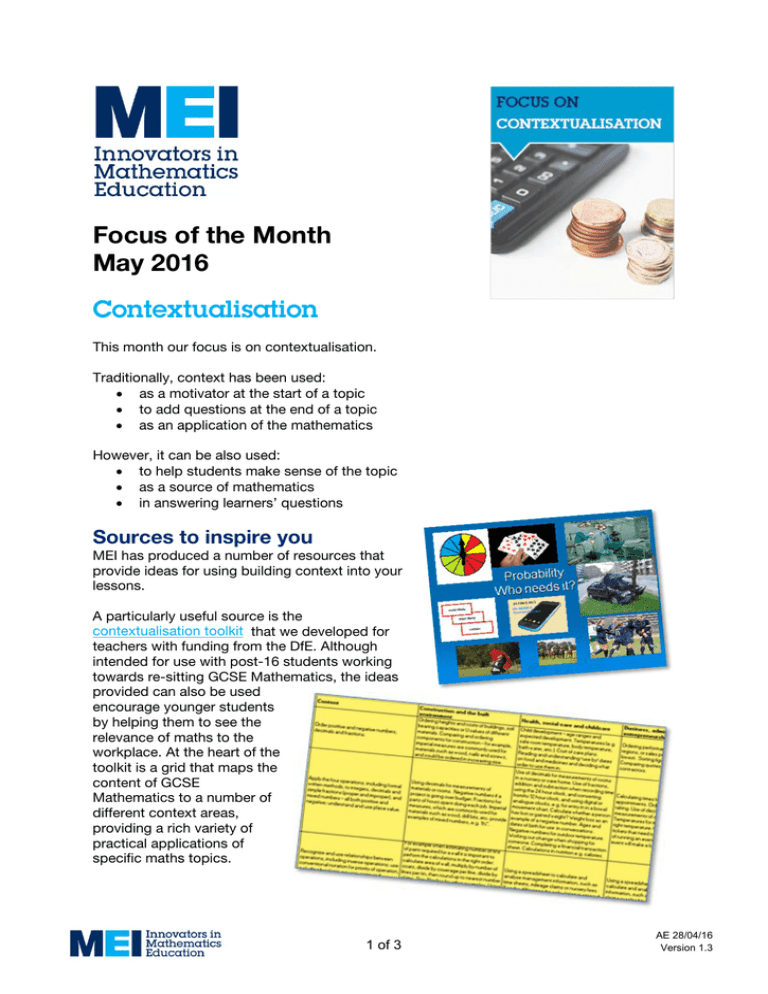
Focus of the Month May 2016 Contextualisation This month our focus is on contextualisation. Traditionally, context has been used: • as a motivator at the start of a topic • to add questions at the end of a topic • as an application of the mathematics However, it can be also used: • to help students make sense of the topic • as a source of mathematics • in answering learners’ questions Sources to inspire you MEI has produced a number of resources that provide ideas for using building context into your lessons. A particularly useful source is the contextualisation toolkit that we developed for teachers with funding from the DfE. Although intended for use with post-16 students working towards re-sitting GCSE Mathematics, the ideas provided can also be used encourage younger students by helping them to see the relevance of maths to the workplace. At the heart of the toolkit is a grid that maps the content of GCSE Mathematics to a number of different context areas, providing a rich variety of practical applications of specific maths topics. 1 of 3 AE 28/04/16 Version 1.3 We have also developed a series of video clips to support the Education and Training Foundation’s Maths Pipeline Programme. These were accompanied by a set of guides to support vocational teaching practitioners in embedding maths: • • • • Construction and the built environment Hospitality and catering Hairdressing and beauty therapy Health and social care Together they provide plenty of inspiration for contextualising maths at KS3 and KS4, as well as for post-16 Functional Skills and GCSE resit. Whilst intended for post-16 students working towards re-sitting GCSE, the ASDAN Short Course in Mathematics, developed by MEI, provides a wealth of activities and investigations for learning maths in context. If you have students involved in work experience, whether it’s at KS4 or KS5 then you might like to take a look at our guides on Integrating work experience and maths learning. Realistic Mathematics Education uses realistic situations to develop mathematical concepts. Some useful resources are: • Using realistic Mathematics Education in UK classrooms • Realistic Mathematics Education as a way of solving problems • Some examples Integral, MEI’s online resources designed to support teaching and learning, includes many excellent resources which make use of context to frame problems. • Finance – for GCSE. • Integrating Maths Problem Solving – maths within other A level subjects. • Core Maths - all Core Maths is context based. More information on Integral, including free samples and subscription rates, is available on our website. There are also ideas about using context in the paper produced by MEI, GCSE Mathematics retake for vocational students. There are four pipes leading into a well. The 1 1 first fills the well in a day, the second in of a 1 2 3 1 day, the third in of a day and the fourth in of a day. 4 5 There are lots of other sources of If they are all filling the well together how long contextualisation of maths available on will it take? the internet, but beware of pseudo contexts. A pseudo-context is one that at first sight looks as though it refers to real-life, but is not actually a realistic problem to pose. When presented with such a use of context, students are likely to ask, “Who would want to know this?” These can easily put-off students. For more information about pseudo contexts, take look at the introduction to our contextualisation toolkit. 2 of 3 AE 28/04/16 Version 1.3 Professional development MEI will be delivering a Contextualised toolkit course at the National STEM Centre in York on 20-21 June. The aim of this course is to develop contextualised resources for use in the classroom. This course attracts ENTHUSE funding and most of the course fees can be reclaimed by state schools and colleges. MEI’s annual conference offers the opportunity for mathematics teachers and enthusiasts to share, explore, discuss and evaluate ideas for the classroom. Sessions cover a wide variety of topics, ensuring that there is always something for everyone, regardless of specification. Presentations and handouts from past MEI annual conference sessions include ideas for using context in mathematics. Some examples are: • Developing contextualised resources for post-16 GCSE Mathematics • The pros and cons of teaching context in the teaching of mathematics The MEI Conference 2016 features many sessions on Core maths, and also includes a session on using real context in GCSE lessons. 3 of 3 AE 28/04/16 Version 1.3
